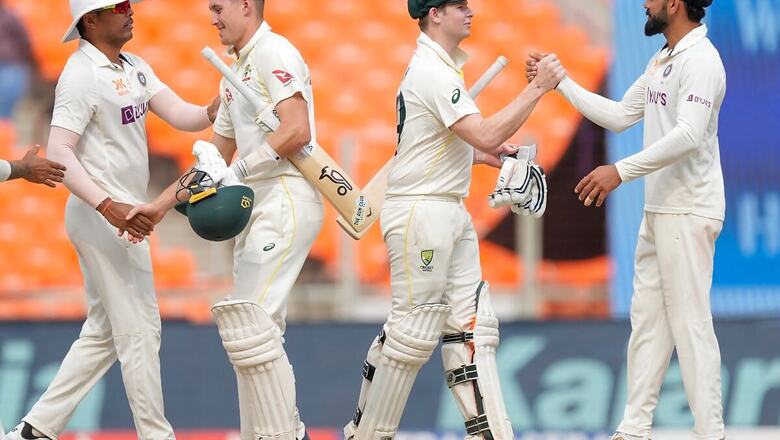
views
Four hundred and sixty one Tests were played during the 2001-2010 decade. While 113 (25%) of those ended in a draw, 348 (75%) produced results. The more interesting numbers are – four Tests (1%) ended on Day 2, 92 Tests (20%) ended on Day 3, 145 Tests (31%) ended on Day 4 and 184 Tests (40%) went on till Day 5.
But the 2000s were the time when the world started moving faster. The decade saw the rise of internet. The period also saw the advent of Facebook and YouTube. It was also over this period that the Bollywood songs started from being quite sober and original to being raps and remix.
Cricket was not spared from the tectonic shift either. T20 cricket was introduced. First international T20 was played in 2004. First T20 World Cup was played in 2007. But the biggest impact of this change was on the five-day cricket.
And when you are good with numbers, the change is quite loudly visible.
Fast forward to 2019 (the year when inaugural World Test Championship cycle began). 161 Tests have been played since the start of 2019. While 25 of those ended in a draw, 136 (84%) Tests produced results. Again, the more interesting numbers – eight Tests (5%) ended on Day 2, 38 Tests (24%) ended on Day 3, 62 Tests were stretched to Day 4 (39%), and 45 Tests (only 28%) saw the light on Day 5.
And hence, there has been a lot of noise around Tests ending earlier and not lasting the distance. While multiple factors might have an impact on the reduced duration of the contests, pitches are considered the primary reason for such a paradigm shift.
This noise just grows louder when the action shifts to the sub-continent. And the increased volume of the noise is quite justified as India has the second least percentage of Tests going into Day 5 (17%) since 2019.
This is an aesthetic, not moral, judgment: the Indore pitch created a Test match more interesting to watch than the Ahmedabad pitch.I’d rather watch 31 wickets fall in 6.5 sessions of Test cricket – than watch 14 fall in ten.
Both extremes, but 5 wickets/session better than 1.
— Michael Appleton (@michelappleton) March 12, 2023
India also produced the shortest Test since the start of 2001 when they hosted England at the newly revamped Motera (now Narendra Modi Stadium) in 2021. The contest had a result within 140 overs and the track was severely criticised.
Also Read: Kohli’s Long-Awaited Century Bodes Well for India Ahead of WTC Final
The decreasing duration of Tests has a direct impact on the outcome, as matches producing results have increased significantly. While 62% Tests in India produced results during between 2001 and 2010, the rate has steeply seen an upward curve – 87% from 2011 to 2014, 78% from 2015-2018, and a staggering 94% since 2019.
If you think this is the best, South Africa have produced 100% results since 2019. Sri Lanka too had a 100% ratio from 2015-2018. On the contrary, South Africa have the least percentage of Tests stretching till Day 5 – 5% (2015 – 2018) and 6% (2019 -2023). Sri Lankan tracks have somehow seen 24% Tests (2019 – 2023) going on till Day 5.
While the sub-continent is famous for producing dust bowls, South Africa have expertly laid mine fields for Tests and have still not caught the limelight.
While pitches are the primary reason for such a hurried pace, a lot of it can also be attributed to the batters’ inability to show patience for a longer duration.
Also Read: India vs Australia Series Meanders to Close, Focus Shifts to WTC Final With IPL in Between
Most of the batters participating in multiple formats including T20Is, are not able to play the time and look to score swiftly. To add to the already fast-paced world, England are turning the format on its head with ‘Bazball’.
The fact is quite evident when the innings-by-innings batting averages in different conditions are considered. The first innings average in India dropped from 40.48 (in 2001-2010) to 33.47 (in 2019-2023). Similarly, the fourth innings average dropped from 29.95 to 22.26. All the major host nations have seen a drop in the innings average in the current period, when compared to the 2001-2010 decade.
One of the primary reason is the World Test Championship pushing teams to go for a result rather than playing out time for stale draws.
Rahul Dravid confessed after the Border-Gavaskar Test in Indore, “With WTC points at stake, you tend to play on wickets that produce results."
And rightly so. A win helps you earn 12 points while a draw leaves you with four points.
The home teams will surely prepare tracks that help produce results, and more so in their own favour.
The ICC in 2019 raised the debate to make Tests a four-day affair. Some of the leading cricketers around the world opposed the international body straightaway. But with the number of Tests going down to Day 5 reducing at a fast pace, is the time ripe to re-start the discussion?
Get the latest Cricket News here




















Comments
0 comment